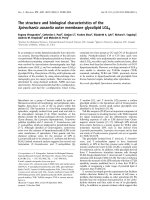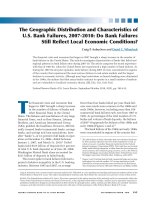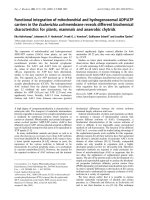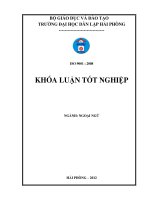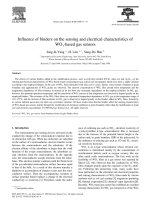Characteristics of the topography and geology of Vung May sea mountain area, Truong Sa, Vietnam
Bạn đang xem bản rút gọn của tài liệu. Xem và tải ngay bản đầy đủ của tài liệu tại đây (1.86 MB, 10 trang )
Journal of Marine Science and Technology; Vol. 17, No. 3; 2017: 242-251
DOI: 10.15625/1859-3097/17/3/10589
/>
CHARACTERISTICS OF THE TOPOGRAPHY AND GEOLOGY OF
VUNG MAY SEA MOUNTAIN AREA, TRUONG SA, VIETNAM
Phi Truong Thanh1*, Duong Quoc Hung2, Nguyen Van Diep2, Le Dinh Nam2
1
Hanoi University of Natural Resources and Environment
2
Instutute of Marine Geology and Geophysics, VAST
*
E-mail:
Received: 3-8-3017
ABSTRACT: Using the REFLEXW software, Ver. 6.0, analysis and processing of high
resolution shallow seismic data of 13 cross section profiles in the Vung May sea mountain area, the
analytical results have divided the boundaries of the reflected layers on the top surface and slope of
sea mountain at each cross section, corresponding to the boundary of the sediment layers based on
the stratigraphy and the results of previous studies in the study area and adjacent areas. In addition,
the analytical results also determined the depth values and coordinate of the seabed surface on each
section, as the basis to build the 3D model of sea mountain surface and draw the topographic cross
sections to calculate the slope angle at each position on the surface around the sea mountain. Based
on the geomorphological characteristics and slope angle, the sea mountain surface is divided into
three parts: Top surface, slope surface and foot surface. Each part of the sea mountain has separate
geological and geomorphological features. At the top surface, the topography has lagoon-shaped
form, surrounded by elevated edge. The size of the lagoon is about 45 km long, 20 km wide, 10 40 m deep and slope angle is smaller than 0.5 degrees (< 0.5o). On the slope surface, topography is
divided into two parts: The first one lies at a depth from the upper flank to -750 m deep, slope angle
is within 8 - 20o; the second one lies at a depth from -750 m to -1,400 -1,500 m, slope angle is
smaller, varies in the range of 4 - 10o. At the foot of sea mountain, the terrain is a large area, at the
depth of -1,400 -1,500 m with slope angle within 1 - 5o. The results obtained in this study are
consistent with previous studies in the area and adjacent areas.
Keywords: High resolution seismic profile, cross sections, coral, topography, slope angle.
INTRODUCTION
The Truong Sa archipelago is located in the
Eastern Vietnam Sea, belongs to the Khanh
Hoa Province and is an integral part of the
Vietnamese territory, has strategic position of
economic aspects, politics and defense security. The Truong Sa archipelago consists of
coral reefs, sand dunes and coral reefs with
hundreds of square meters. The area of the
islands in the Truong Sa archipelago is very
small, no more than 5 km². The average height
of the islands ranges from 2.5 m to 3.5 m,
242
especially the height of Song Tu Tay island is
6.0 m [1]. The surface area of the islands in the
area of the Truong Sa archipelago depends on
the season and the meteorological and regional
conditions of the area. The slope angle of these
islands varies within 20 - 30o [2].
The studies in the Truong Sa archipelago
area have been conducted since the 16th
century by Western navigators and the Truong
Sa archipelago was named by the Royal Navy
in 1843. It is also an international name
commonly used to refer to the Truong Sa
Characteristics of the topography and geology…
archipelagos of Vietnam. Since 1922, the
French began to exploit the Truong Sa and
Hoang Sa archipelago. The most typical
geological study of the islands and continental
shelf of Vietnam is based on the results of the
initial
survey
on
the
topography,
geomorphology and seabed sediments, is E.
Saurin (1950-1960).
Since the late 1960s, a series of foreign
petroleum companies from Russia, USA,
Australia, Germany, France, Italy, UK,
Malaysia...
conducted
geological
and
geophysical surveys in the Sea, including the
Truong Sa islands and Tu Chinh - Vung May
sea mountain. In particular, there was
geological and geophysical study in the Sea,
including the Truong Sa archipelago from the
Far East Center, the Russian Academy of
Sciences. After this period, the geological
features and tectonic structure of the Truong Sa
archipelago and Tu Chinh - Vung May have
been mentioned in other studies by [3-5],...
In Vietnam, the Truong Sa archipelago and
Tu Chinh - Vung May has been studied for a
long time, under Le-Trinh Kingdoom (16th and
17th centuries) and the real researches in this
area have just started after 1975. And to serve
the goal of developing sea-island economy and
protecting territorial waters, surveys in this area
began to be carried out continuously from 1993
to present on the islands and sea mountains of
the Truong Sa archipelago through State-level
research projects belonging to the East Sea Truong Sa program. A series of structural
tectonic studies at this stage is published,
typically they are the studies of [6-18],…
In this issue, the studies of [7, 8, 19] have
described in detail the terrain and
geomorphologic
features
and
material
components... in the islands belonging to the
Truong Sa archipelago; [1] have analyzed in
detail the geological and terrain features of
Song Tu Tay, Truong Sa, Nam Yet and Son Ca
islands in the Truong Sa archipelago; [20] have
used a geophysical method to analyze the
geophysical features of the crust to determine
the layer surfaces of the Earth’s crust, fault
systems and sedimentary formations of Truong
Sa archipelago area.
Later, [21] used geological data, collected in
April 1998, to analyze the chemical composition
of the samples in Phan Vinh sea mountain area,
Da Tay and has indicated that coral reefs with a
major origin have biological sedimentary,
relatively monotonic carbonate composition;
[22] gave an overview of development trends of
coral reef in the Truong Sa archipelago.
However, most of the above studies have not yet
quantified the geomorphological characteristics
of each island and sea mountain in the Truong
Sa archipelago area.
In this paper, using the high resolution
shallow seismic data collected in 2003 from the
project: “The survey of geology, geophysics
and meteorology in the Southwest of Truong Sa
archipelago and adjacent continental shelf”
performed by Vu Nang Pham and using
REFLEXW software, Ver. 6.0 together with
some other specialized softwares, the authors
will clarify the topographic and morphological
characteristics of Vung May sea mountain
within the region 7o26’35.31’’ - 8o8’1.2’’N,
111o15’50.23’’ - 111o48’ (fig. 1).
Fig. 1. Map of study location
MATERIAL AND METHODS
Material
The data used to analyse topological and
morphological characteristics of Vung May sea
mountain area in three dimensional space (3D)
243
Phi Truong Thanh, Duong Quoc Hung,…
are high resolution shallow seismic data of 13
lines with total length of 461.14 km which are
collected from GEONT equipment, Sparker
resource, made in Russia, through the project:
“The survey of geology, geophysics and
meteorology in the Southwest of Truong Sa
archipelago and adjacent continental shelf”,
performed by Vu Nang Pham (2003). The
location of the high resolution shallow seismic
survey lines is shown in fig. 2.
stratigraphic method. In particular, the GIS
method is used to draw maps, determine study
locations and other information on the map; the
seismic stratigraphic method is used to analyse
and process seismic data through REFLEXW
software, Ver. 6.0, including the below steps:
Step 1: The seismic data collected from
the Sparker sources are converted and
formatted to process using REFLEXW
software, Ver. 6.0, including: Signal filtering,
deconvolution and stacking to get the high
quality of seismic profiles, reflecting clear
boundaries and seismological characteristics.
Step 2: Using the seismic-stratigraphic
method, the boundary of the seismic sequences
is divided based on the contrast in intensity and
frequency; continuity and stability of
synchronous axes... are the base to connect
stratigraphy of the adjacent areas.
Step 3: Building the seismic - geological
cross sections; seabed terrain; reflected surfaces
and the thickness of the sedimentary layer in
three dimensional space (3D). Besides, the
analyses of the angle of the topographic surface
are also determined by using software which is
programmed from the Visual Basic language
Ver. 6.0 and other modules.
ANALYTICAL RESULTS
Topographic
characteristics
and
geomorphologic
The analysis and building of the
topographic surface of the Vung May sea
mountain area in 3D are conducted on 12 high
resolution shallow seismic lines in fig. 2 and
are presented in fig. 3.
These profiles are then located according to
their positions and represented in 3D as shown
in fig. 4.
Fig. 2. Map of the high resolution shallow
seismic survey lines in Vung May sea
mountain area
Methods
The method used in this paper include:
Mapping method - GIS and seismic244
By using the REFLEXW software, Ver. 6.0,
high resolution shallow seismic profiles are
processed and filtered to separate the reflecting
layers, corresponding to the boundary of the
sedimentation sequences and determine the
depth values of topographic surface on the each
section. The depth value is expressed by the
Characteristics of the topography and geology…
points X, Y, Z, corresponding to the value of
each depth and coordinates (latitude longitude). These depth values are then
interpolated using Surfer software, Ver. 12.0
and represented in 3D as in fig. 5.
S
E
W
N
0
Depth (m)
Depth (m)
0
-500
-1000
-1500
-500
-1000
VM-07
VM-01
-2000
-1500
10
20
30
0
50
40
5
15
20
25
Distance (km)
Distance (km)
S
N
E
W
0
Depth (m)
0
Depth (m)
10
-500
-1000
-400
-800
VM-02
-1500
VM-08
-1200
10
20
40
30
50
0
5
Distance (km)
S
N
15
20
E
W
0
0
-500
Depth (m)
Depth (m)
10
Distance (km)
-1000
-1500
-400
-800
VM-03
-2000
VM-09
-1200
0
5
10
15
20
25
30
35 40
0
45
5
Distance (km)
15
20
25
Distance (km)
S
N
E
W
0
0
Depth (m)
-500
Depth (m)
10
-1000
-1500
VM-04
5
10
15
20
25
30
Distance (km)
-1000
VM-10
-1500
-2000
0
-500
35
40
45
0
5
10
15
20
25
Distance (km)
Fig. 3. High resolution shallow seismic profiles
of Vung May mountain area
Fig. 4. Location of high resolution shallow
seismic profiles in Vung May sea mountain
area in 3D
Fig. 5. Three-dimensional (3D) model of
terrain surface and cross section lines in the
Vung May mountain area
The surface of Vung May sea mountain
area after plotting in 3D has the elliptical form
in north-south direction, within coordinates of
7o26’35.31’’ - 8o8’1.2’’N, 111o15’50.23’’ 111o48’E with 50 - 53 km long, 20 - 25 km
wide.
To
analyse
geomorphologic
and
topographic characteristics in Vung May sea
mountain area, the topographic cross section
lines are designed as in fig. 6.
The topographic cross section lines in fig. 6
are plotted in fig. 7.
The analytical results of each cross section
in Vung May sea mountain area determine that
the top surface is relatively flat; the slope
surface around the sea mountain has the slope
angle varying from 5o to 20o, at the depth from
5 - 6 m to -1,900 -2,000 m. Based on the
topographic differentiation of the digital model
and on the cross-sections, the topographic
surface of the Vung May sea mountain and
adjacent area is divided into three separate
parts: Top surface, slope surface and foot
surface.
245
Depth (m)
Depth (m)
Depth (m)
Depth (m)
Depth (m)
The top surface: Is quite flat, surrounded by
the edge, forming lagoons with slope angle
smaller than 5o (< 0.5o). In the center of the sea
mountain, lagoon is about 45 km long and
20 km wide, 10 - 40 km deep (fig. 8).
Depth (m)
Phi Truong Thanh, Duong Quoc Hung,…
Fig. 7. Topographic cross sections
of Vung May sea mountain area
Fig. 8. Cross sections A-A’ and B-B’ in the
directions of NW-SE and NE-SW through
the Vung May sea mountain center
Fig. 9. Cross-section of the topography around
the Vung May sea mountain area
Fig. 6. Topography of the Vung May sea
mountain area interpolated from the high
resolution shallow seismic data
At the edge, their structure is complex. The
elevation between the edge and the center of
the lagoon is about 40 - 50 m. The edge is
below the current water level from 1 - 2 m to
10 - 20 m. The edge terrain is not flat with
thousands of meters of difference (fig. 9).
According to the degree of closure of the edge,
this type is open loop atoll (fig. 9).
246
Sea mountain slope: The analytical results
of the digital topographic, the high resolution
shallow seismic profiles and topography cross
sections in fig. 3, 7 and 8 show that the surface
of sea mountain slope has wavy form, running
from the top surface to the foot of sea
mountain. The geomorphology of this sea
mountain is quite even around.
Based on slope angle, the terrain surface
can be divided into two parts: The first one is in
the depth from the top surface to -750 m, with
the slope angle within 8 - 20o; the second one is
Characteristics of the topography and geology…
in the depth from -750 m to -1,500 m, with the
slope angle within 4 - 10o (fig. 7).
The foot of sea mountain: Is a large area,
surrounded at the depth of -1,400 m to deeper.
It is seen on the high resolution shallow seismic
profiles, being cut in the W-E direction. The
angle of foot surface area is within 1 - 5o.
Geological characteristics
The Truong Sa archipelago belongs to the
transition zone between the continental and
oceanic crust. Their basement structure is cut
strongly, forming graben and half graben,
deposited by Cenozoic sediments. The
characteristics of the sediment of this area are
determined on the basis of seismic data, sea
bottom geological samples and deep-sea
drilling samples. [21] and the other authors
suggested that the geological characteristics of
the islands belonging to the Truong Sa
archipelago have the same coral origin.
The atolls and coral reefs in the Truong Sa
archipelago are formed on positive geological
structures with large size. At the top of these
structures, lighting conditions are sufficient
temperature and salinity of seawater are
consistent with coral growth. The basic part of
positive structures can have magnetic origin or
eruptions. The results of exploratory drilling in
the islands such as Song Tu Tay and large
Truong Sa islands showed that at the depth of
30 m, there are solid coral reefs with the
component of CaCO3. The result of the
interpretation of the stratigraphic seismic
profiles of Vung May sea mountain area
determined the different sedimentary layers on
the top surface, slope based on analyzing
seismic data.
The first layer is defined as a complex
structure, consisting of sand, coral reefs
mudflats, boulders, pebbles and coral gravels,
with loose structure to weak bonds. The layer
thickness varies from 7 - 8 m at the edge of the
lagoon and around the overhanging blocks to
15 - 16 m in the middle of the lagoon.
The comparative results of borehole data
on the islands and the sea mountain in the
Truong Sa archipelago determined that this
sedimentary layer was formed during the
Holocene-present period (from 11 - 12
thousand years to now).
The second layer is characterized by blank
waves, identified as sand, gravel which was
formed by the weathering process, due to the
destruction of the frame of coral, during the late
Pleistocene regression. This layer has a
thickness which varies strongly, mainly in the
range of 10 - 20 m.
The third layer is characterized by a subclass wave with horizontal synchronous
reflections or bend with average amplitude.
This layer consists of the sandwiched layers of
mud and coral reefs of various shapes and
sizes, formed due to the destruction of coral
reef rock formations at the coastal zones and
the blocks, under the influence of sea waves.
The layer is 15 - 25 m thick and predicted as
early-mid Pleistocene.
The top surface area
On the seismic profile VM02-06 (fig. 10),
the sedimentary layers on the top surface are
located at the center of the lagoon and in the
depression between the high blocks along the
edge zone, reflecting clearly sedimentary layers
from the top to the bottom. Based on
comparing the previous studies in the area [2,
8, 14, 17, 21-23], the geological characteristics
of each layer are presented as follows:
Fig. 10. Characteristics of sedimentary layers
on the top surface of high resolution shallow
seismic profile VM02-06 in the north
of Vung May sea mountain area
The slope of the sea mountain
Similarly, in the lower slope part of cross247
Phi Truong Thanh, Duong Quoc Hung,…
section VM02-06, seismic waves do not clearly
indicate the sedimentary layers, reflecting the
complexity of the geological structure. The
sedimentary layer thickness varies from 20 to
200 - 300 m in the lower slope and 700 - 800 m
at the foot of sea mountain (fig. 11).
clayey mud, with significant thickness,
intercalated with sand, gravel and coral reefs.
The third layer lies on the top of the coral
massif with a uniform structure, having a
thickness of about 150 m, consisting mainly of
moderate to solid coral sandstone formations.
In the lower part of the slope, the occurrence of
uniform reflection waves can be observed with,
strong amplitude, bending, showing the
presence of thin clay layers, coral boulders and
branches.
The foot of sea mountain
Fig. 11. Sedimentary layer in the lower part of
the slope on the high resolution shallow section
VM02-06, in the north of Vung May sea
mountain area
Similar to the top surface, the sedimentary
formations on the slope can also be divided into
the following three layers:
The first layer is characterized by the
blank wave, relatively homogeneous at the top,
gradually changed to the layered form with the
phases from medium to strong at the lower part
of sea mountain and it has the thickness
increasing toward the depth of slope, from 20 30 m at the upper part to 40 - 50 m at the lower
part. The wave field of this layer reflects the
heterogeneity of the geological structure on the
slope area. The analytical results compared to
the adjacent area showed that this layer consists
of sand, weakly bonded coral reefs, intercalated
with the thin clay layers, changing along the
slope area.
The second layer is characterized by the
tilted axis of the wave, bend, discontinuity and
amplitude decrease according to the depth of
the slope. The thickness of this layer varies
from 15 m to 20 m at the top, increases to 40 50 m at the bottom. Similar to the first one, the
second wave field also reflects the geological
heterogeneity of structure across the entire
layer. The geological formations are defined as
248
The seismic waves are the uniform axes,
parallel to each other, reflecting clearly
structural layers. On the seismic profile VM0206, through the deep water 1,950 - 2,000 m in
the north of Vung May sea mountain area, the
sedimentary layers are 600 - 700 m in
thickness, structured in five layers, formed
during the transgression period of PlioceneQuaternary. The supply of sedimentary
material was determined to be from the top
surface and the slope surface area. The analysis
results on the other high resolution shallow
seismic sections in Vung May sea mountain
area were also in the same as the seismic
profile VM02-06.
According to Pham Nang Vu (2003), the
Vung May sea mountain area and other islands
in the Truong Sa archipelago area are formed
by the coral masses. In the Vung May sea
mountain, the rock masses are about 500 600 m in height, formed on the high land of
older rocks in the period of Oligocene - Late
Miocene and developed continuously from late
Miocene to present, through 3 main stages:
The stage 1: The coral mass is built at the
top of ancient rock blocks, in the transgression
stage (Late Miocene - Early Pliocene) at the
depth of 450 - 500 m.
The stage 2: The coral mass is expanded
during the regression in the Late PlioceneQuaternary and the sediment is deposited at the
foot of sea mountain area.
The stage 3: The top part is coral mass,
having the thickness of about 400 - 500 m, with
Characteristics of the topography and geology…
steep slope and no sedimentary formations are
covered.
research result in the vast area of the Truong Sa
archipelago.
The monolithic coral masses are
surrounded by sedimentary layers with 20 m in
thickness, many holes, karst, formed by coral
rock of many generations, sometimes filled by
mud and broken coral. On the high resolution
shallow seismic profiles, the top layer is
characterized by uniform wave axis, bent, tiled,
superimposed with amplitude from medium to
weak. The coral rock mass is solid and
homogeneous, characterized by blank wave.
In order to carry out the strategy of political
economy and defense-security, the study in
detail and quantitative characteristics of
geology and geomorphology on the island and
sea mountain in the Truong Sa archipelago
should be further promoted in many research
programs.
CONCLUSIONS
The analytical results from the high
resolution shallow seismic data of 13 crosssections in Vung May sea mountain area within
the coordinates (7o26’35.31’’ - 8o8’1.2’’N,
111o15’50.23’’ - 111o48’E) using the
REFLEXW software, Ver. 6.0 have determined
the boundary of reflective surfaces of seabed
and sedimentary sequences. The values of
seabed on each high resolution shallow seismic
profile are obtained, including: Coordinates
(longitude and latitude) and depth, being a base
for creating three dimensional model, drawing
the topographic cross section and calculating
the slope angle.
Based on the calculated program of slope
angle on the seabed surface, programmed from
Visual Basic 6.0 language and other modules,
the slope angle of the seabed surface reflects
clearly the difference among top surface, slope
and foot of sea mountain. In particular, at the
top surface the topography has lagoon-shaped
form, and is surrounded by elevated edge with
about 45 km long, 20 km wide, 10 - 40 m deep
and slope angle is smaller than 0.5 degree
(< 0.5o); at the slope surface, topography is
divided into two parts: The first one lies at a
depth from the upper flank to the -750 m deep,
slope angle is within 8 - 20o; the second one
lies at a depth of -750 m to -1,400 - 1,500 m,
slope angle is smaller, varies in the range of 4 10o; at the foot surface, the terrain is in large
size, at the depth -1,400 -1,500 m with slope
angle within 1 - 5o. The results obtained in this
study are consistent with some previous studies
in the adjacent area. However, this is only a
REFERENCES
1. Nguyen The Tiep, 1996. Geomorphological
and geological features of the Truong Sa
archipelago. Contributions of marine
geology and geophysics, Vol. II. Science
and Technics Publishing House, Hanoi. Pp.
146-155.
2. Bui Thi Bao Anh, Do Huy Cuong, Nguyen
Duc Thanh, Nguyen Thi Nhan, 2014. The
geoengineering basis for the construction of
buildings on the islands and under sea level
plains belonging to Truong Sa archipelago.
Journal of Marine Science and Technology,
12(4A), 171-178.
3. Holloway, N. H., 1982. North Palawan
block, Philippines-Its relation to Asian
mainland and role in evolution of South
China Sea. AAPG Bulletin, 66(9), 13551383.
4. Hinz, K., and Schlüter, H. U., 1985.
Geology of the Dangerous Grounds, South
China Sea (Vietnam East Sea), and the
continental margin off southwest Palawan:
results of SONNE Cruises SO-23 and SO27. Energy, 10(3-4), 297-315.
5. Hinz, K., and Schlüter, H. U., 1985.
Geology of the Dangerous Grounds, South
China Sea (Vietnam East Sea), and the
continental margin off southwest Palawan:
results of SONNE Cruises SO-23 and SO27. Energy, 10(3-4), 297-315.
6. Do Tuyet, 1978. Some features of
geomorphology in the Truong Sa
archipelago. Journal of Geology, (136),
16-19.
7. Nguyen Bieu, 1985. Some features of
geology in the Truong Sa archipelago.
Journal of Geology, (169).
249
Phi Truong Thanh, Duong Quoc Hung,…
8. Tran Van Hoang, 1996. The problem of
protection for geological environment in the
rise islands belonging to Truong Sa
archipelagos. Contributions of marine
geology and geophysics, Vol VII. Science
and Technics Publishing House. Pp. 169-171.
9. Bui Cong Que et al., 1998. Some features
of the Earth’s crust structure in the Truong
Sa archipelago area according to
geophysical data. Contributions of Marine
Geology and Geophysics. Publishing
House for Science and Technology. Pp.
115-126.
10. Le Duc An, 1998. Some characteristics of
seabed geomorphology in the Truong Sa
archipelago
and
adjacent
area.
Contributions of natural condition and
natural resources of the Truong Sa
archipelago. Publishing House for Science
and Technology. Pp. 37-42.
11. Le Duc An, 1999. General data on the
geomorphology of coral plateaus in the
Hoang Sa and Truong Sa archipelagos.
Vienam Journal of Earth Sciences, 21(2),
153-160.
12. Bo Nguyen Quang, Nguyen Du Hung, Tran
Quan Hoan, Nguyen Van Dac, Tran Duc
Chinh, 1998. Tu Chinh Bank area in
structural plan of Southeast Vietnam
continental shelf. PetroVietnam ReviewMay.
13. Nguyen The Tiep, 1998. Characteristics of
geomorphology and geology in the Truong
Sa archipelago area. Contributions of natural
condition and natural resources of the
Truong Sa archipelago. Publishing House
for Science and Technology. Pp. 26-36.
14. Tran Duc Thanh, 1998. Some chacteristics
of geology in the Truong Sa archipelago.
Contributions of natural condition and
natural resources of the Truong Sa
archipelago. Publishing House for Science
and Technology. Pp. 93-103.
15. Nguyen Nhu Trung et al., 2002.
Characteristics of deep structure in the
Truong Sa archipelago area according to
satellite gravity data. Vienam Journal of
Earth Sciences, 24(2), 348-361.
250
16. Nguyen Van Luong, Le Tram, Le Quoc
Hung, 2002. Terrain and geological
structure around the Spratly Islands
according to high resolution shallow
seismic data and Echo sound data. Vienam
Journal of Earth Sciences, 24, 146-154.
17. Nguyen Tu Dan et
al.,
2006.
Geomorphology of coral formations in the
Truong Sa archipelago. Vietnam Academy
of Science and Technology, (6), 92-101.
18. Le Dinh Nam et al., 2013. The principle
geomorphological characteristics of Spratly
islands and Tu Chinh-Vung May areas. The
second national scientific conference on
marine geology, Hanoi - Ha long, 10-12
October. Publishing House for Science and
Technology. Pp. 207-218.
19. Nguyen Van Bach et al., 1998. Some
characteristics
of
topography
geomorphology and sediments of shallow
water in the Truong Sa sea. Journal of
Geology, (247).
20. Bui Cong Que, Nguyen Van Giap, Nguyen
Thu Huong, Le Tram, Nguyen Duc Thanh,
Do Huy Cuong, Tran Tuan Dung, 1996.
Some characteristics of the Earth’s crust
structure of the Truong Sa region based on
the geophysical data. Contributions of
marine geology and geophysics, Vol. II.
Science and Technics Publishing House,
Hanoi. Pp. 13-22.
21. Ngo Van Quang, Pham Quoc Hiep, 2003.
The principal geological and petrochemical
characteristics of the reef-forming rocks of
the top section of some islands in Truong
Sa (Spratly) archipelago. Contributions of
marine geology and geophysics, Vol. VII.
Science and Technics Publishing House.
Pp. 87-97.
22. Nguyen Tien Hai, Nguyen Van Bach,
Nguyen Huy Phuc, Nguyen Trung Thanh,
2003. Tendency of development and
changeable hidden of atolls in the Truong Sa
island region. Contributions of marine
geology and geophysics, Vol. VII. Science
and Technics Publishing House. Pp. 285-292.
23. Duong Quoc Hung, Thanh Nhi Bui,
Nguyen Kim Thanh, Nguyen Van Diep,
Characteristics of the topography and geology…
2012.
The
shallow
geological
characteristics of Truong Sa Island water
submerged area according to high
resolution seismic data. Contributions of
marine geology and geophysics, Vol XII.
Science and Technics Publishing House.
Pp. 115-121.
251


